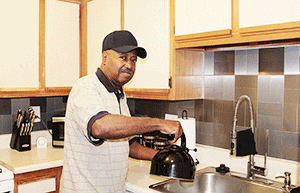
Many veterans have specific experiences that lend themselves to a different mix of services than other people leaving homelessness might need.
In many cases, a branch of the military has been the only employer that a young man or woman has known. Employment readiness skills such as how to look for a job, write a resume, and practice interviewing are all essential for veterans transitioning into civilian life. We also understand that being on “kitchen patrol” in a mess hall is completely different than having to care for a place of your own, which make life-skills courses, such as fire safety and housekeeping, an important component.
A quick review of any military branch’s creed will reveal the paramount importance placed on one’s unit, so creating an environment that functions as a community can be important for creating comfort. Community building must be at the core of any Housing First veterans’ project.
Many veterans, especially those who have ended up homeless, are also suffering from PTSD. The Veterans Health Administration has engaged recreational therapists to provide equine therapy for PTSD management. Working with a horse, which weighs upwards of 1,200 pounds, requires focus, taking attention away from an inner struggle. Over a period of time, the individual becomes more relaxed, learns the horse’s personality, and bonds with the animal in a nonverbal way which ultimately promotes positive societal behavior. Similar success has been found when veterans train service dogs. These programs are designed to build trust and camaraderie, which carries over to other residents and makes the whole community stronger.
However, none of these programs will work for veterans who are not stably housed first. Continued successful outcomes like these require a greater emphasis on getting veterans rapidly housed in support-enriched communities. Leveraging the Housing First model, the industry as a whole can not only improve the speed and efficiency of delivering services to veterans, but also combine those lessons learned to tackle the broader homelessness problem.
For more on the topic of veterans, homelessness, and housing, see Shelterforce's “Almost Home“ Spring 2014 issue.
(Photo credit: Air Force veteran Norris Fletcher received a HUD-VASH voucher. Courtesy of the Housing Authority of DeKalb County).





That’s my amazing Gdaddy! Miss you so much! Such an beautiful soul.